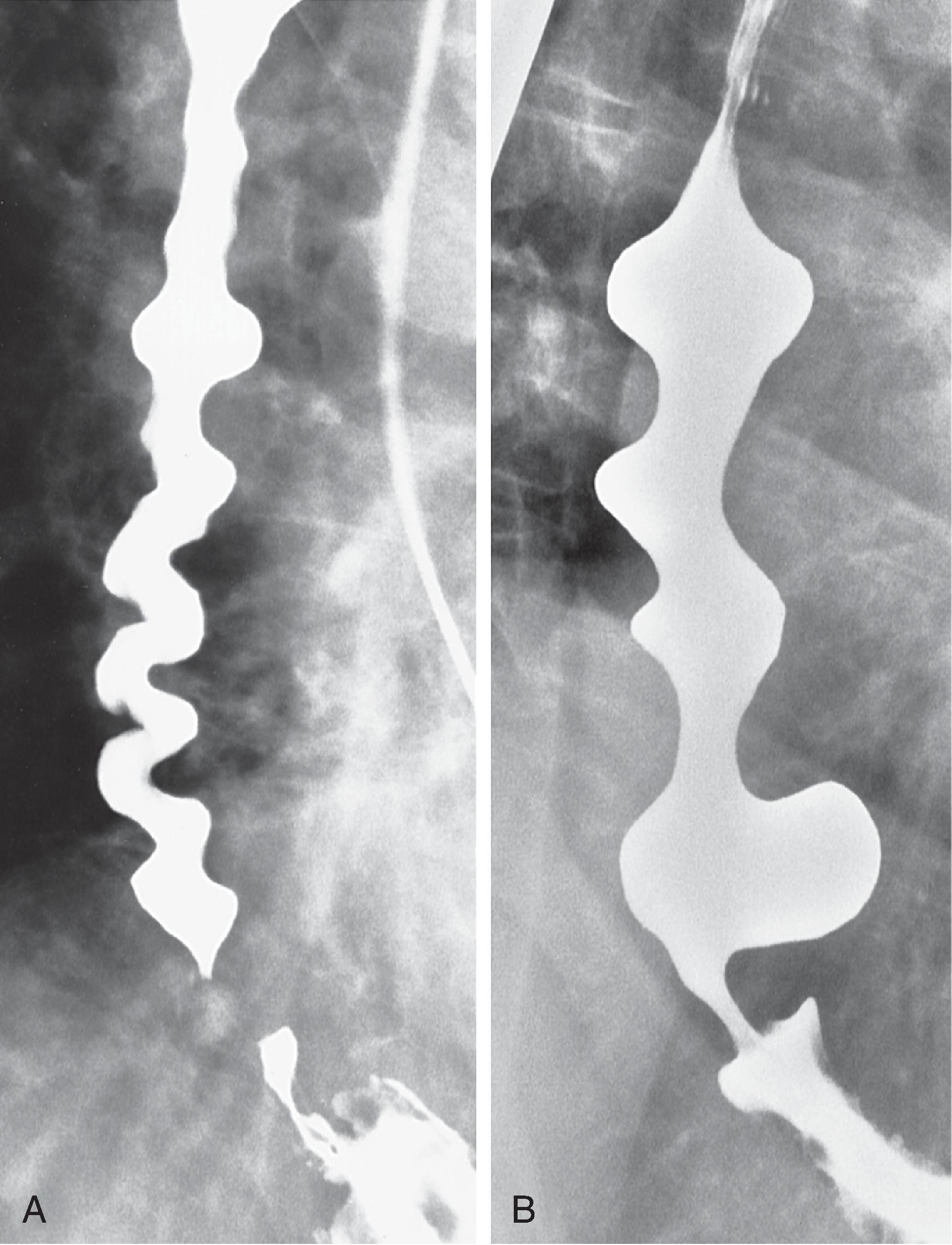Physical Address
304 North Cardinal St.
Dorchester Center, MA 02124
Motility disorders of the esophagus are an important cause of esophageal symptoms, especially symptoms not readily explained by structural abnormalities. This chapter reviews esophageal anatomy and physiology before discussing fluoroscopic evaluation of esophageal motility and major esophageal motility disorders.
The esophagus is a 20- to 24-cm long muscular tube composed of outer longitudinal and inner circular muscle fibers. Striated muscle predominates in the upper third of the esophagus and smooth muscle in the lower two-thirds. The transition from striated to smooth muscle usually occurs at the level of the aortic arch, , with most esophageal motility disorders selectively involving the striated or smooth muscle portions of the esophagus above or below this level.
Opening and closing of the upper and lower ends of the esophagus are regulated by the upper esophageal sphincter (UES) and lower esophageal sphincter (LES), respectively. The UES is located at the pharyngoesophageal junction and is formed primarily by the cricopharyngeal muscle. In contrast, the LES is not a distinct anatomic entity but is defined manometrically as a high-pressure zone in the esophagogastric region. ,
In the resting state, the esophagus is normally collapsed, and the UES and LES are closed to prevent retrograde flow of esophageal and gastric contents. , The chief mechanism of transport of a swallowed bolus is esophageal peristalsis, which is facilitated by gravity in the upright position. Radiographic evaluation of esophageal motility is therefore performed with the patient in a recumbent position to eliminate the effect of gravity.
Primary esophageal peristalsis is initiated by swallowing. A rapid inhibition wave is followed by a slower contraction wave, which generally traverses the esophagus in 6 to 8 seconds. Relaxation of the UES occurs less than 1 second after initiation of swallowing, and relaxation of the LES occurs several seconds later, enabling the oncoming bolus to enter the stomach. , ,
Secondary peristalsis and nonperistaltic contractions (NPCs) are other types of esophageal functional activity. , Secondary peristalsis is initiated by local esophageal stimulation or distention but is otherwise similar to primary peristalsis, propagating aborally. In contrast, NPCs (also known as “tertiary” contractions) are not propagated aborally and may be single or multiple, simultaneous or repetitive, and feeble or strong ( Fig. 7.1 ). Severe NPCs can narrow or even obliterate the esophageal lumen, producing a characteristic “corkscrew” appearance on barium studies (see Fig. 7.1A ). However, most NPCs are not lumen obliterating and occur as nonspecific findings related to a variety of esophageal motility disorders.

Radiographic evaluation of esophageal motility includes examination of the body of the esophagus as well as the UES and LES. , During swallowing, the UES normally opens in response to bolus distention. Incomplete opening of the UES may be manifested on barium studies by a persistent, rounded indentation on the posterior aspect of the pharyngoesophageal junction due to a contracted cricopharyngeal muscle (see Chapter 5 ). , This finding is often associated with other signs of pharyngeal dysmotility, such as stasis or aspiration. Motion-recording techniques are needed for dynamic evaluation of the pharynx and UES.
Fluoroscopic examination can be used to evaluate esophageal motility, but motion-recording techniques facilitate assessment of the findings. The patient is placed in a prone, right anterior oblique (RAO) position and instructed to take single swallows of barium. Five discrete swallows are ideally required for adequate evaluation of esophageal peristalsis. , Single swallows must be observed because a second swallow taken before completion of the preceding swallow inhibits the propagating wave, erroneously suggesting a peristaltic abnormality. In contrast, rapid swallowing of multiple boluses of barium does not assess primary esophageal peristalsis but maximally distends the esophagus for structural evaluation.
A normal peristaltic sequence is seen at fluoroscopy as an aboral contraction wave that progressively strips the barium bolus from the esophagus. This lumen-obliterating wave imparts an inverted V configuration at the top of the barium column that traverses the entire esophagus, normally clearing the entire swallowed barium bolus from the esophagus. Occasionally, however, weakening of peristalsis occurs at the level of the aortic arch because of a low-amplitude pressure zone at the transition between the striated and smooth muscle portions of the esophagus. , , As a result, a small amount of barium may squirt in a retrograde fashion above the aortic arch on some swallows. This so-called “proximal escape” is an age-related phenomenon that causes no esophageal symptoms and has no clinical importance, so it should not be mistaken for true esophageal motility disorders.
Disruption of primary peristalsis often occurs as a normal finding associated with aging. As a result, barium studies may reveal intermittent weakening or absence of primary peristalsis and a variable number of NPCs in older patients. This age-related phenomenon (also known as “presbyesophagus”) is rarely associated with dysphagia or chest pain and therefore is not felt to be a clinically important finding in older patients with no esophageal symptoms. Whatever terminology is used, presbyesophagus is a clinically trivial condition that should be differentiated from diffuse esophageal spasm (DES) and other motility disorders causing dysphagia or chest pain.
Esophageal motility disorders may be classified as primary or secondary ( Table 7.1 ). , , Primary esophageal motility disorders mainly involve the esophagus, whereas secondary esophageal motility disorders result from a wide variety of systemic diseases involving the esophagus.
| Primary Motility Disorders (Newer Clinical Categories) |
| Achalasia and variants (inadequate lower esophageal sphincter relaxation) Diffuse esophageal spasm (uncoordinated contraction) Nonspecific esophageal motility disorder (hypocontraction) Presbyesophagus (questionable entity—hypocontraction) |
| SECONDARY MOTILITY DISORDERS (MANY WITH HYPOCONTRACTION) |
Collagen vascular disease (especially scleroderma)Chemical or physical agents
Infectious causesDiabetes mellitusAlcoholismEndocrine diseaseNeuromuscular disorders
Idiopathic intestinal pseudo-obstruction |
Become a Clinical Tree membership for Full access and enjoy Unlimited articles
If you are a member. Log in here